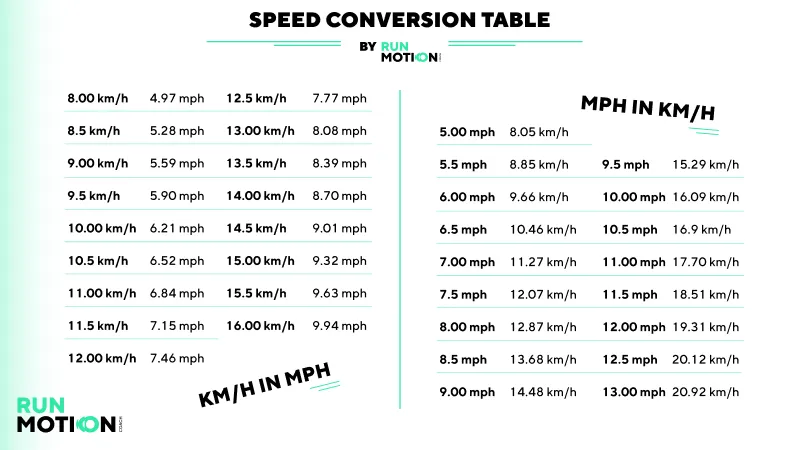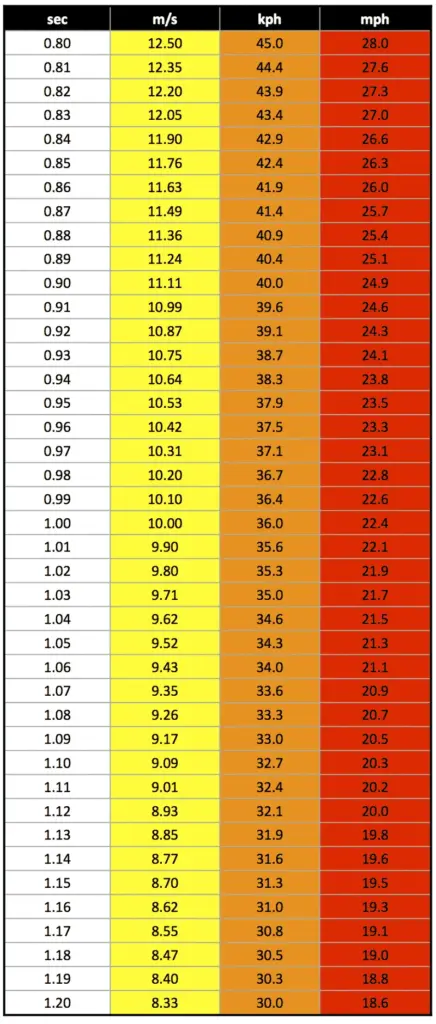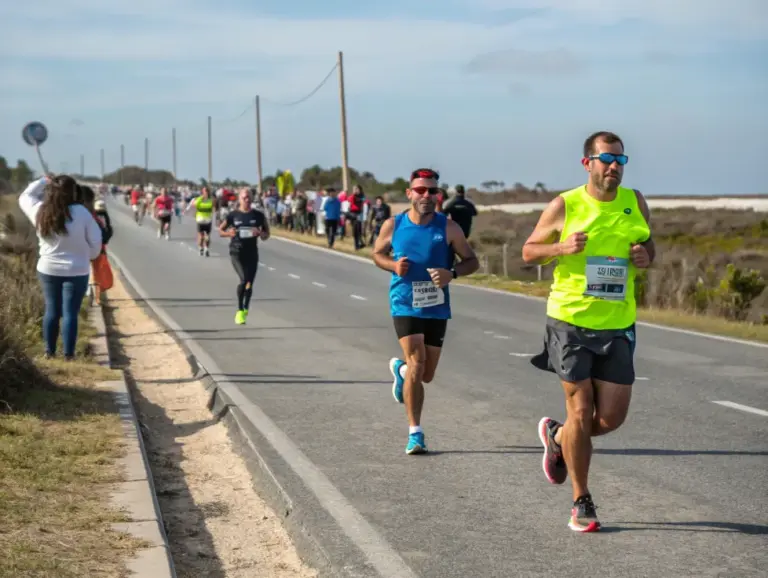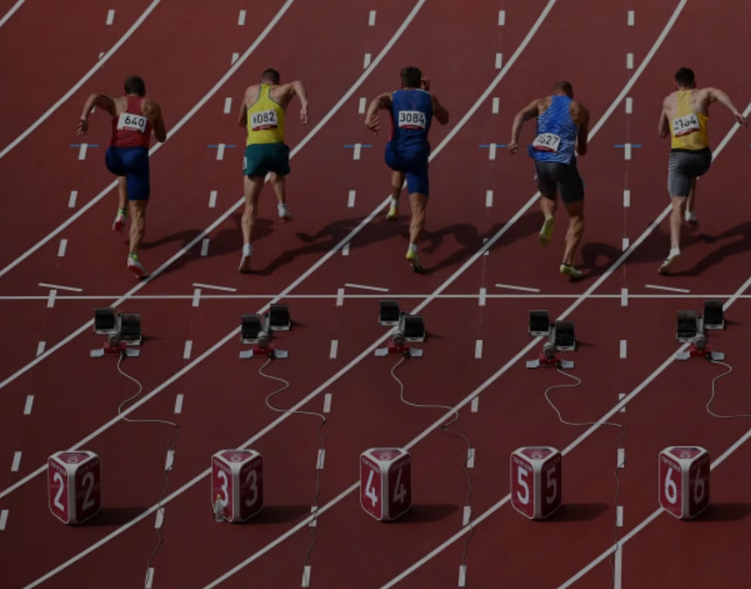Km/h to Mph Converter: How to Switch Speed Units Like a Pro
Ever looked at your running watch and wondered what 10 km/h means in miles per hour? Or maybe you’re prepping for a race in the US or UK where they use miles instead of kilometers. Whatever your reason, knowing how to convert between km/h and mph can make a big difference — especially if you’re training, racing, or just tracking your progress with accuracy.
In this guide, you’ll find not only how to convert speeds but also when and why it matters. We’ll walk through simple formulas, handy tools, and even provide you with a ready-to-use conversion table. Whether you’re an athlete, a traveler, or just curious — this is your go-to breakdown.
Why Convert Kilometers per Hour to Miles per Hour?
If you’re from Europe, Asia, or basically anywhere outside the US or UK, you’re probably used to speeds in kilometers per hour (km/h). That’s because most of the world follows the metric system. However, in countries like the United States, United Kingdom, and a few others, speed limits, GPS apps, and race paces are listed in miles per hour (mph).
So if you’re:
- Traveling to an English-speaking country
- Competing in a marathon abroad
- Reading race recaps, training plans, or treadmills showing mph
…you’ll need a quick and reliable way to convert your familiar km/h values into mph — and back.
How to Use a Km/h to Mph Converter
The simplest way is with an online converter. Just input your speed in either km/h or mph, and it instantly shows the equivalent in the other unit. Most fitness apps, including Garmin, Strava, and RunMotion Coach, allow this conversion.
If you’re offline or just love doing it yourself, the good news is: you don’t need calculus. Just multiplication. Let’s break it down.

Conversion Formulas: Km/h to Mph and Vice Versa
The formulas are straightforward and easy to remember:
- To convert kilometers per hour to miles per hour:
mph = km/h × 0.621371 - To convert miles per hour to kilometers per hour:
km/h = mph × 1.60934
So let’s say you’re running at 12 km/h. Using the formula:
12 × 0.621371 = 7.46 mph
Or if you’re driving at 60 mph, and want to know the metric equivalent:
60 × 1.60934 = 96.56 km/h
This kind of quick math helps keep your training or trip smooth without needing to constantly search for conversion tools.
Speed Conversion Table: Km/h to Mph (and Vice Versa)
Here’s a practical reference table for popular running and driving speeds. Use it during workouts, trip planning, or while watching international races:
| Kilometers/hour | Miles/hour | Kilometers/hour | Miles/hour |
|---|---|---|---|
| 7.50 km/h | 4.66 mph | 14.00 km/h | 8.70 mph |
| 7.75 km/h | 4.82 mph | 14.25 km/h | 8.85 mph |
| 8.00 km/h | 4.97 mph | 14.50 km/h | 9.01 mph |
| 8.25 km/h | 5.13 mph | 14.75 km/h | 9.17 mph |
| 8.50 km/h | 5.28 mph | 15.00 km/h | 9.32 mph |
| 8.75 km/h | 5.44 mph | 15.25 km/h | 9.48 mph |
| 9.00 km/h | 5.59 mph | 15.50 km/h | 9.63 mph |
| 9.25 km/h | 5.75 mph | 15.75 km/h | 9.79 mph |
| 9.50 km/h | 5.90 mph | 16.00 km/h | 9.94 mph |
| 9.75 km/h | 6.06 mph | 16.25 km/h | 10.10 mph |
| 10.00 km/h | 6.21 mph | 16.50 km/h | 10.25 mph |
| 10.25 km/h | 6.37 mph | 16.75 km/h | 10.41 mph |
| 10.50 km/h | 6.52 mph | 17.00 km/h | 10.56 mph |
| 10.75 km/h | 6.68 mph | 17.25 km/h | 10.72 mph |
| 11.00 km/h | 6.84 mph | 17.50 km/h | 10.87 mph |
| 11.25 km/h | 6.99 mph | 17.75 km/h | 11.03 mph |
| 11.50 km/h | 7.15 mph | 18.00 km/h | 11.18 mph |
| 11.75 km/h | 7.30 mph | 18.25 km/h | 11.34 mph |
| 12.00 km/h | 7.46 mph | 18.50 km/h | 11.50 mph |
| 12.25 km/h | 7.61 mph | 18.75 km/h | 11.65 mph |
| 12.50 km/h | 7.77 mph | 19.00 km/h | 11.81 mph |
| 12.75 km/h | 7.92 mph | 19.25 km/h | 11.96 mph |
| 13.00 km/h | 8.08 mph | 19.50 km/h | 12.12 mph |
| 13.25 km/h | 8.23 mph | 19.75 km/h | 12.27 mph |
| 13.50 km/h | 8.39 mph | 20.00 km/h | 12.43 mph |
| 13.75 km/h | 8.54 mph | — | — |
Feel free to screenshot or save this chart — it works well for treadmill workouts or long runs with pace targets in mixed units.

When to Use Each Unit of Speed
Knowing both units comes in handy in more situations than you’d think. Here’s where each one typically appears:
- Km/h (Kilometers per hour):
Standard in Europe, Asia, Africa, South America, most of the world.
Used in car speedometers, road signs, fitness apps in metric countries. - Mph (Miles per hour):
Used in the U.S., U.K., Liberia, some Caribbean countries.
Common on treadmills in gyms, U.S. GPS systems, and marathon pace guides in English-speaking countries.
So if you’re pacing for a 10K in Europe but using a U.S.-based training plan, converting units will help keep your goals aligned.
Mastering Speed Conversion: Practical Tips and Use Cases
Now that you know the formulas, have a working speed conversion table, and understand when to use km/h or mph, let’s look at the real-world applications. Whether you’re an athlete, a traveler, or a fitness enthusiast, speed conversion isn’t just about numbers — it’s about syncing your progress across borders, apps, and machines.
Real-Life Scenarios: When Speed Conversion Matters
Let’s make it personal. Imagine these situations:
1. Training for a Race in the U.S. or U.K.
You’re used to pacing your runs at 10 km/h, but you’ve just signed up for the Chicago Marathon or London 10K. Most training plans you find list paces in miles per hour or minutes per mile.
If you can’t convert quickly, you risk misjudging your effort level or misreading your GPS data. A wrong pace by even 0.5 mph over 42 kilometers could mean finishing 10–15 minutes behind your goal.
2. Treadmill Confusion at the Gym
You hop on a treadmill in a U.S. hotel. The machine only displays mph, and you’re trying to do a steady 12 km/h run. That’s about 7.46 mph, by the way. Without conversion knowledge or a table nearby, you’ll likely guess — and guess wrong.
3. Using Global Running Apps
Many running apps default to local unit systems — Strava, RunKeeper, Nike Run Club often sync with your phone’s locale settings. If you move countries, travel, or join a challenge with international friends, you’ll see a mix of units and need to convert on the fly.
Pro Tips for Speed Conversions On the Go
- Use Voice Commands:
Ask Siri, Alexa, or Google Assistant — “What’s 13 kilometers per hour in miles per hour?” Instant results. - Use Smartwatch Settings:
Garmin, Coros, and Polar allow you to set display units to either km/h or mph. Choose based on your race goals or location. - Screenshot Conversion Tables:
Save a mobile image of the chart from this article in your phone gallery for quick reference during warmups or treadmill workouts. - Mental Benchmarks:
Memorize a few common conversion points. For example:- 10 km/h ≈ 6.2 mph
- 12 km/h ≈ 7.5 mph
- 15 km/h ≈ 9.3 mph
These round numbers can help you estimate pace quickly without needing your calculator.
Speed and Effort: What Conversion Doesn’t Show
Here’s where it gets tricky — converting speed tells you how fast you’re going, but it doesn’t always reflect effort. For instance, running at 10 km/h on a flat road is not the same as running 6.2 mph on a treadmill with incline or on a hilly trail.

Other factors to consider:
- Wind resistance
- Gradient (uphill/downhill)
- Temperature and humidity
- Fatigue and elevation gain
So while km/h to mph conversion is helpful, always contextualize your pace with the environment. Don’t just chase the numbers — understand what they mean for your body.
Kilometers per Hour vs. Miles per Hour: Quick Comparison
| Feature | Kilometers per Hour (km/h) | Miles per Hour (mph) |
|---|---|---|
| Used in | Most countries worldwide | US, UK, Liberia |
| Conversion factor | 1 km/h = 0.621371 mph | 1 mph = 1.60934 km/h |
| Typical running pace | 8–14 km/h | 5–9 mph |
| Preferred in apps like | Strava (metric settings) | Treadmills, US-based plans |
Use this as a cheat sheet when switching between units on the go.
Recap: What You’ve Learned
Let’s summarize the essentials from this guide:
- Conversion is simple math:
Multiply km/h by 0.621371 to get mph
Multiply mph by 1.60934 to get km/h - Conversion helps:
When traveling, racing abroad, or training with international programs - The table matters:
Use it to track effort, set treadmill speeds, and align GPS feedback - Know your units:
Metric is the global standard, imperial is still used in a few key regions
Make Conversion a Habit
The more comfortable you are switching between km/h and mph, the easier it becomes to understand your fitness journey in any context. It’s not just about numbers—it’s about awareness.
Want to run your next 5K at 13.5 km/h? That’s 8.39 mph. Now you know.
Need to maintain 6 mph for your tempo workout? That’s 9.66 km/h. You’re covered.
So whether you’re chasing a PR, exploring new countries, or just trying to understand your treadmill settings — speed conversion is a skill that every modern runner, traveler, or cyclist should have in their pocket.
Now lace up, get moving, and don’t let units slow you down.







